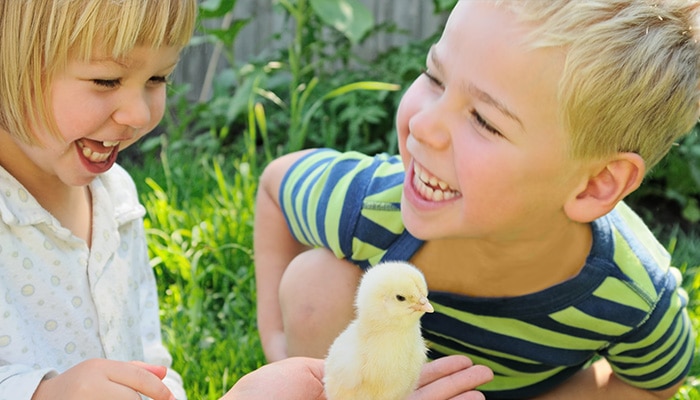While we believe that the books and resources recommended may be of value to you, keep in mind that these are suggestions only and you must do your own due diligence to determine whether the materials are appropriate and suitable for your use. PNC has no sponsorship or endorsement agreement with the authors or publishers of the materials listed.
ANIMAL FRIENDS

Feathered Friends
Children will investigate bird feathers.

Lesson Objective
Children will investigate bird feathers and perform an experiment to determine how important feathers are to birds and how oil can harm them.
Science
What You'll Need
- Bird feathers – 1 per child
- Magnifying glasses – 1 per child
- Small bowls – 3 per small group
- Vegetable oil – ½ cup per small group
- Dawn dishwashing liquid – 1 bottle (Dawn is recommended due to its ability to remove oil)
- Soft toothbrushes – 1 per child
- Water
What To Do
Note: Divide the children into small groups. For each group, fill 1 bowl with water, fill 1 bowl with oil, and fill another bowl with a mixture of 1 tablespoon dishwashing liquid to 1 cup warm water.
- Distribute feathers and magnifying glasses. Have the children examine the feathers structure using the magnifying glasses (see Guiding Student Inquiry).
- Tell the children about the construction of the feathers and their importance in providing cover and protection for the bird (see Did You Know?).
- Ask the children to make predictions about what might happen to the feather if it gets wet (see Guiding Student Inquiry).
- Distribute the bowls of water, and have the children dip their feathers into the bowl.
- Discuss what the feather looks like.
- Ask the children to predict what would happen to the feather if it were dipped in oil.
- Distribute the bowls of oil, and have the children dip their feathers into the bowl of oil.
- Discuss how the structure of the feather changed.
- Tell the children that they will be experimenting with trying to remove the oil from the feather.
- Have the children dip the oiled feather in the plain water. Distribute toothbrushes, and instruct children to use the toothbrush to gently try to remove the oil. Discuss what happens.
- Distribute the bowls of soapy water, and have the children dip their toothbrushes in the soapy water to clean the feather. Discuss what happens.
- Ask the children to try to comb the feathers with their fingers, much like a bird would do when it uses its beak to clean itself and restore its waterproofing.
- Discuss how difficult it is to comb the feathers. Remind the children that a bird’s feathers are important in protecting the bird’s sensitive skin.
- Explain that just a small amount of oil on a bird can be very dangerous (see Did You Know?).
Resources
Home School Resources
Home educators: use these printable lesson PDFs to teach this lesson to your home schoolers. They're available in English and Spanish.
Content Provided By
Common Core State Standards Initiative – These lessons are aligned with the Common Core State Standards ("CCSS"). The CCSS provide a consistent, clear understanding of the concepts and skills children are expected to learn and guide teachers to provide their students with opportunities to gain these important skills and foundational knowledge [1]. Visit the CCSS


